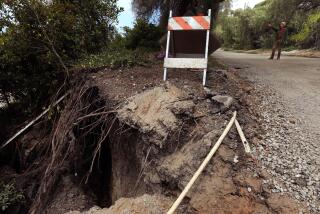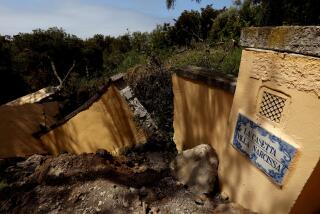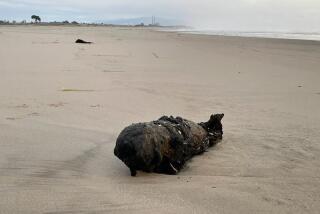Fissure Closes Runway at Edwards
- Share via
Worried officials at Edwards Air Force Base said Wednesday that a half-mile-long crack, up to 12 feet deep and four feet wide, has closed one of the base’s famous dry lake runways, the latest bad news in the increasing problem with ground subsidence in the Antelope Valley.
The huge fissure on Rogers Dry Lake opened only about five miles from a runway used by space shuttles and many experimental jets. It may be the largest such fissure ever discovered in California, said Devin Galloway, a spokesman for the U.S. Geological Survey.
Like other, smaller cracks that have been appearing in the region, it appears to have been caused by the pumping of ground water, authorities said.
Its discovery and the prospect of increased ground water pumping in coming months due to the drought have base officials worried that the problem could spread, threatening shuttle landings and the future of the base.
“This is the largest fissure I’ve seen on the lake bed,” said Larry Plews, a civilian Air Force engineer who oversees the runway facility. He expressed concern that more such fissures could open nearby.
“Just because the fissure happened on one runway doesn’t mean it won’t happen on another runway,” he said.
The 44-square-mile lake bed, unique in the country, is critical to the base because its clay surface provides long, wide, comparatively smooth natural runways suited to landings from many directions by space shuttles and experimental jets. The availability of the lake bed landing grounds was a factor in establishing the base in the Mojave Desert, about 90 miles northeast of Los Angeles, as the nation’s premier flight test facility during World War II.
News of the huge fissure on the base came on the heels of a new study that found extensive ground cracking within the adjoining city of Lancaster, including areas near a planned state prison and Los Angeles County hospital.
The study released this week reinforced previous reports that some parts of the Antelope Valley have sunk up to five feet in 60 years.
The three-month study, commissioned by the city, suggested that Lancaster officials restrict development until further studies can be done. The study found no fissures the size of the lake bed crack in the city, but many smaller ones up to 700 feet long and about one foot wide. The study did not give depths, but city officials and geologists have reported cracks in some Lancaster neighborhoods measuring 12 to 15 feet deep.
Air Force officials discovered the crack in the landing field after a rain about two weeks ago. It runs generally north and south at the southern end of the lake bed, cutting through runway 7/25, a four-mile east-west strip that base officials closed immediately.
Assistant airfield manager Mel Marmet said the runway will remain closed for at least a month until an Army geologist and others can study the fissure.
Base officials began noticing smaller cracks on the lake bed several years ago.
Marmet also disclosed Wednesday that runway 17/35--a 7 1/2-mile strip that is the base’s longest runway and was once commonly used by space shuttles--was put out of service for shuttle landings last year because the southern end was crumbling from lack of rain.
He said much of the lake bed’s surface has been deteriorating in recent months due to lack of rain, which combined with desert winds to smooth its surface. Although most of the base’s runways are natural strips on the lake bed, widespread ground fissuring would also threaten its conventional, paved runways.
The only known way to slow or stop the ground sinking and cracking in the region, geologists say, is to stop pumping ground water, which currently accounts for about half of all water used by the Antelope Valley’s approximately 260,000 residents.
The air base traditionally has relied on its own wells for water. But because of concern that its pumping might be contributing to the lake bed cracking problem, Air Force officials had hoped to buy about 1 billion gallons a year from the state water project, starting this year.
Whether the state will have water to sell remains a question, since the drought has forced water officials to threaten delivery cutbacks of up to 85%. Ground water pumping elsewhere in the valley is likely to increase soon, both because of the state cutbacks and higher summer use by residents of the desert area.
More to Read
Sign up for Essential California
The most important California stories and recommendations in your inbox every morning.
You may occasionally receive promotional content from the Los Angeles Times.










